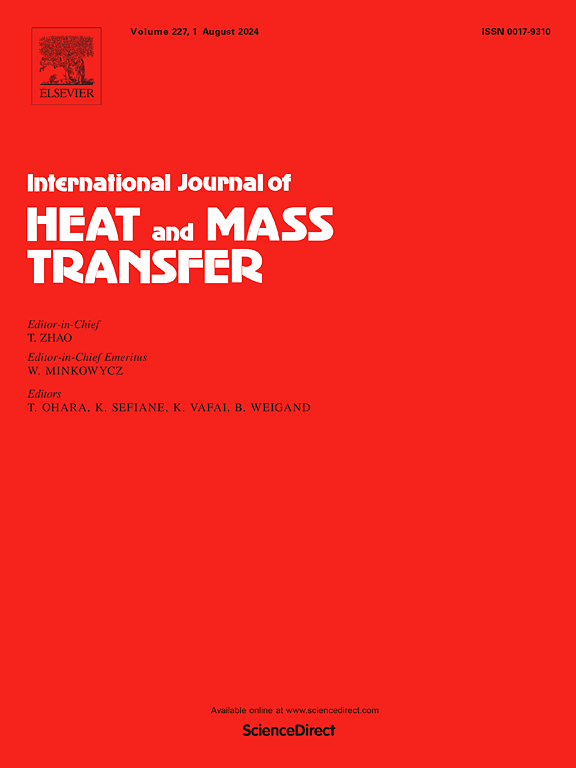Direct-on-chip two-phase jet impingement cooling of multichip packages: Distributed inlet-outlet nozzles
IF 5
2区 工程技术
Q1 ENGINEERING, MECHANICAL
International Journal of Heat and Mass Transfer
Pub Date : 2025-07-11
DOI:10.1016/j.ijheatmasstransfer.2025.127514
引用次数: 0
Abstract
This study introduces a package-level, direct-on-chip two-phase jet impingement cooling system utilizing R1233zd(E) refrigerant for a multi-chip server. The experimental arrangement includes a heater setup, replicating the NVIDIA P100 chip. The manifold houses distributed inlet-outlet nozzles arrays which sequentially cools the four low-powered High Bandwidth Memories (HBMs) followed by high-powered logic chip. The heat transfer and hydraulic pressure characteristics of both the logic chip and HBMs are systematically examined. (1) In logic-only case, the boiling curves at different flow rates converge into a single curve within the two-phase regime. The critical heat flux (CHF) reaches a maximum of 66.4 W/cm² at a flow rate of 2.5 L/min. (2) In HBMs-only case, boiling curves across individual HBMs similarly show a single distinct curve in the two-phase regime. CHF in HBMs was only observed at the lowest flow rate, with the maximum flux dissipated being 45 W/cm2. (3) In simultaneous power dissipation in all chips, HBM power had no observable effect on logic chip CHF. At maximum HBM power dissipation, the logic chip’s CHF remained nearly constant at 66.4 W/cm². In total, the system dissipated 612.8 W (452.8 W in the logic chip and 40 W in each HBM). The heat flux had no noticeable impact on the cooler’s pressure drop, which peaked at 29.1 kPa (at 2.5 L/min). This work provides foundational insights into heat transfer and pressure dynamics in multi-chip modules within a confined package environment. The findings offer valuable guidance for implementing effective two-phase jet cooling in multi-chip systems.
多芯片封装的直接片上两相射流冲击冷却:分布式进出口喷嘴
本研究介绍了一种采用R1233zd(E)制冷剂的封装级直接片上两相射流冲击冷却系统,用于多芯片服务器。实验安排包括一个加热器设置,复制NVIDIA P100芯片。歧管包含分布的进出口喷嘴阵列,依次冷却四个低功耗高带宽存储器(HBMs),然后是高功率逻辑芯片。系统地研究了逻辑芯片和HBMs的传热和液压特性。(1)在纯逻辑情况下,不同流速下的沸腾曲线在两相状态下收敛为一条曲线。当流量为2.5 L/min时,临界热流密度(CHF)达到66.4 W/cm²。(2)在仅HBMs的情况下,跨单个HBMs的沸腾曲线在两相状态下类似地呈现出单一的明显曲线。HBMs仅在最低流量下观察到CHF,最大耗散通量为45 W/cm2。(3)在各芯片同时功耗中,HBM功率对逻辑芯片CHF无明显影响。在最大HBM功耗下,逻辑芯片的CHF几乎保持不变,为66.4 W/cm²。系统的总功耗为612.8 W(逻辑芯片为452.8 W,每个HBM为40 W)。热流密度对冷却器压降无明显影响,其压降峰值为29.1 kPa (2.5 L/min)。这项工作提供了在一个封闭的封装环境中的多芯片模块的传热和压力动力学的基本见解。研究结果为在多芯片系统中实现有效的两相射流冷却提供了有价值的指导。
本文章由计算机程序翻译,如有差异,请以英文原文为准。
求助全文
约1分钟内获得全文
求助全文
来源期刊
CiteScore
10.30
自引率
13.50%
发文量
1319
审稿时长
41 days
期刊介绍:
International Journal of Heat and Mass Transfer is the vehicle for the exchange of basic ideas in heat and mass transfer between research workers and engineers throughout the world. It focuses on both analytical and experimental research, with an emphasis on contributions which increase the basic understanding of transfer processes and their application to engineering problems.
Topics include:
-New methods of measuring and/or correlating transport-property data
-Energy engineering
-Environmental applications of heat and/or mass transfer

 求助内容:
求助内容: 应助结果提醒方式:
应助结果提醒方式:


